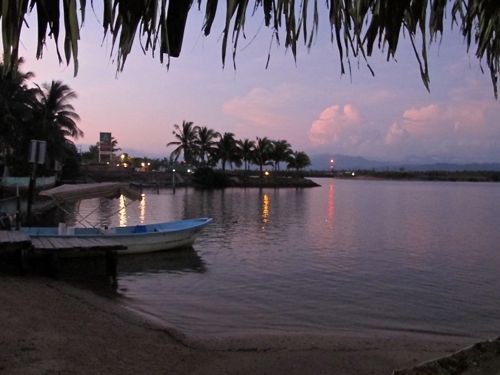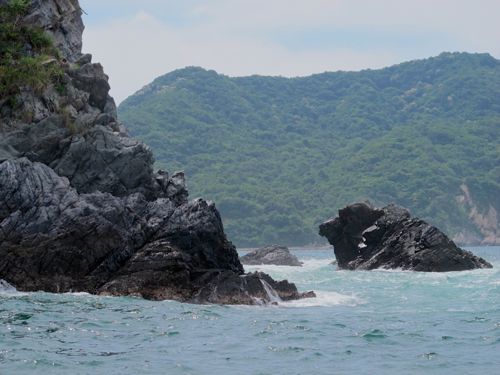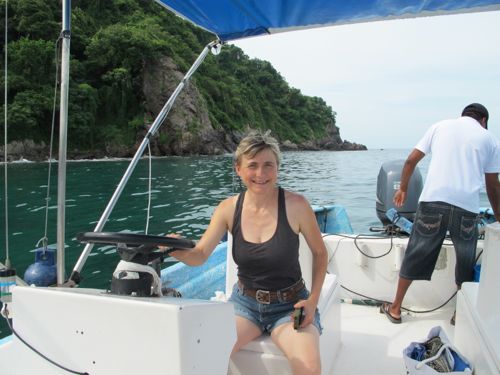
Part 1 of a series
CUIXMALA, Costalegre, Mexico – A precious undeveloped remnant of coastline along the Pacific Ocean revealed a few of her secrets to me over a few days this autumn, secrets I will never forget.
The sight of a protective mother brown booby protecting her downy white baby from raiding iguanas on an island off the coast; a sea turtle laying her glistening round eggs on the beach by the light of the moon; the soft feel of a baby in my hand as I place it on the sand and watch it make its way toward the waves; the crashing sound of a crocodile in the darkness of the mangrove, and the lurking form of another alongside our small boat; the forms of two white sharks far below me as I peer out from an airplane soaring over the coastline.
Here in the Chamela-Cuixmala Biosphere Reserve, a wilderness awaits, oblivious to the predators that lurk on the horizon, overshadowing the dangers of any number of crocodiles or sharks. Negotiations are underway for a new airport less than 30 minutes down the highway, which is being widened on the stretch that runs from Puerto Vallarta to Manzanillo, including the unspoiled stretch in the middle known as the Costalegre, the Joyful Coast.
No one is sure how quickly the development will come, but coastal residents report that huge tracts have been bought up by developers with plans to replicate what has happened to the north of Puerto Vallarta, where previously sleepy fishing villages and wild coastline have been incorporated into the highly promoted Riviera Nayarit. The areas around Puerto Vallarta and Manzanillo have been fully exploited, and investors are hungry to create the next exciting new destination.

This stretch of Pacific Coast, with its dramatic granite outcroppings interspersed with precious palm-fringed private beaches, throbbing with wildlife and caressed with warm breezes, seems poised to be that destination, and those who love it for its wildness are bracing for the worst – and working for the best possible outcome. Meanwhile, to the independent travelers who prefer their highways shady and their beaches unspoiled, a couple of words of advice: Look South.
Some travelers may prefer to fly in to Puerto Vallarta, rent a car and head south on the spectacular Highway 200, which winds its way between cliffs and sea, visiting seaside villages like Yelapa and Mismaloya, the location for the filming of the steamy 1954 classic Night of the Iguana with Liz Taylor and Richard Burton.
My sister Toni and I live in Guadalajara, so we chose a different route, starting in the south with Barra de Navidad, the charming southern boundary of the Costalegre, and working our way north. What we found was a coastal wonderland with something for every budget. Accommodations range from family-run palapas on the beach to Cuixmala, the magical hideaway and nature preserve that was once the private estate of a British millionaire.
Barra de Navidad/Melaque
We chose as our base the homey artistic Casa Holistica Sol, a guesthouse and healing center run by the remarkable Lucero de Avila, a medicine woman and practitioner of various transformational therapies. A beautiful adobe temazcal, the ancient Mexican version of the sauna or sweat lodge, graces the patio, along with a mural of a woman invoking the spirits – a woman looking remarkably like Lucero. On a previous visit Lucero transported me on a brief journey to an inner world in this temazcal. This time she was off on another journey.
We arrived in this charming seaside village, home to many Canadian and U.S. expats and a beautiful siren gazing out to sea, just in time to enjoy the sparkling rays of a golden evening over the harbor. Hernán, one of several fishermen-turned-tour operators whom we met there, offered us a leisurely boat ride over to the Isla de Navidad. He delivered us to the dock of Lydia’s, one of a collection of palapa-covered open-air seafood restaurants. We chose a plate of oysters so fresh their hearts were still beating, and a big plate of pescado zarandeado – local sea bass grilled in the Sinaloa style with chili and garlic and tomato sauce. It was, in a word, divine, and we savored every bite as the sun slowly dropped over the horizon.
The next day we took Hernán up on an offer to go snorkeling and see some of the fantastic rock formations along this dramatic shoreline. It was Toni’s first time snorkeling, and I asked him to join us in the water and give her a hand. He helped us both with our snorkels and flippers and quickly found a pocket of brilliantly colored fish swimming around: big ones, with pale blue heads and dark blue bodies, and little bright blue ones with neon-blue and orange spots, and yellow ones with black stripes, and whole schools of flashing silvery ones. We put our heads down and entered their world, flowing with the currents, watching to our hearts’ content.

The next morning we headed up the coast to explore Barra’s sister city, Melaque. Don’t be dissuaded by the scrappy collection of cheap hotels, private residences and the occasional mini-super that greet you upon your entrance into the town. We wandered lost for a while and finally decided it must just not be a good time to visit Melaque, and headed on up the coast to greener highways. On the way home, we accidentally found ourselves at the heart of the town in a pretty plaza surrounded with interesting businesses and filled with life, expats and Mexicans alike enjoying the breezes from what we later learned are some of the area’s best beaches. Just another reason to return.
More on Barra de Navidad here:
Adventure meets elegance in Barra de Navidad and here: Healing at the Casa Holistica Sol
Leave a Reply